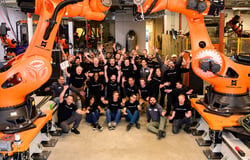About Us
Amidon Heavy Industries is a startup building unmanned systems for the offshore industry. We develop uncrewed surface vessels (USVs) that autonomously deploy tethered remotely operated vehicles (ROVs) to inspect subsea pipelines, telecom cables, and offshore infrastructure. Our goal is to deliver reliable subsea awareness at a fraction of the cost of traditional crewed vessels.
The Role:
We are hiring a Robotics Software Engineer (Perception & Sensors) to support sensor selection, integration, and testing on our next-generation autonomous surface vessel. You will work closely with senior engineers to turn a proven prototype into a product-ready platform that can operate reliably in real-world marine environments. This is a hands-on role where you will contribute to sensor integration, data collection optimization, and post-processing pipelines. You will gain exposure to marine autonomy systems, dead-reckoning, and ingestion optimization while taking ownership of sensor selection that directly impacts the performance and reliability of our platform.
Responsibilities:
Integrate, calibrate, and configure sensors for an autonomous surface vehicle (sonar, acoustics, visual) to support reliable data collection in high fidelity environments
Optimize sensor data collection pipelines and post-processing workflows
Support sensor data ingestion for use in navigation and autonomy stacks
Contribute to system-level integration and testing
Participate in at-sea trials, verifying sensor data, and troubleshooting sensor related issues
Assist in visualization, logging, and playback tools for analyzing recorded test data
Participate in selection of new perception tools
Qualifications:
Degree in Robotics, Computer Science, Mechatronics, or related field
1-3 years of experience (or equivalent project work) in sensor integration (e.g., cameras, LiDAR, sonar, radar, GNSS, IMU) data ingestion pipelines, autonomy, or related software development
Proficiency in C++ and Python in a Linux environment
Experience working with modern robotics middleware, specifically ROS2 (nodes, messages, services/actions, launch systems, and tooling)
Demonstrated hands-on experience with real-world robotics or embedded systems
Experience with network and software optimization and network communication protocols
Knowledge of sensor data structures and perception libraries (e.g., PCL, OpenCV)
Experience with peripheral communication protocols (e.g., CAN, UART, SPI, etc.)
Experience with sensor fusion, localization, and navigation algorithms
Bonus Points:
Background in marine or maritime engineering, naval architecture, or marine robotics
Experience with modern simulation and visualization platforms (e.g., RViz, Gazebo/Ignition, Webots, Unity, Unreal Engine)
Familiarity with embedded operating systems and edge-compute hardware (e.g., NVIDIA Jetson, real-time or resource-constrained systems)
Experience with collaborative software development tools (e.g., Git-based workflows, code reviews, CI/CD pipelines) and project management tools (JIRA)
Experience working with Autonomous Underwater Vehicles, particularly sonar and acoustic sensors
Experience building or using hardware-in-the-loop (HIL) or software-in-the-loop (SIL) test setups
Top Skills

What We Do
Today’s ocean infrastructure is vast, vital, and exposed. Our autonomous systems provide the continuous presence needed to detect threats, prevent failures, and secure the subsea environments that keep the world running. We help operators move from reactive maintenance to proactive resilience: cutting costs, reducing risk, and raising the bar for reliability.










